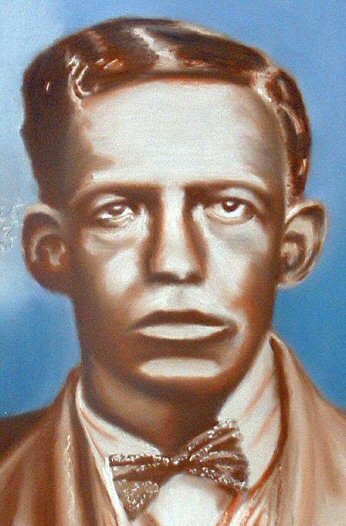
Painting © 2004 Loz
Arkle
Website
© Copyright 2000-2011 Alan White - All
Rights Reserved
Site optimised for Microsoft Internet Explorer
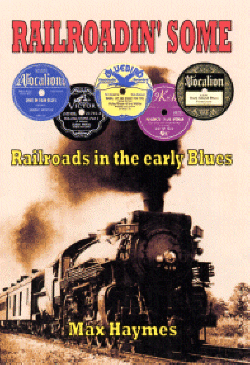
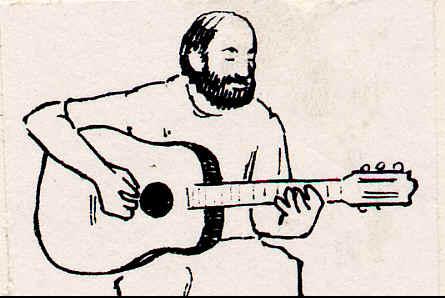

Background of Recorded Blues By Max Haymes
This is the third of a series of short surveys on the content and meaning of some early blues which takes in the social, economic and cultural strands of the life-situation for Blues singers in the first decades of the 20th century. The appreciation of some titles will also be included. The early Blues, at its highest level, is art (working-class art) every bit as much as say the works of Picasso or Beethoven. Indeed, in a hand-out on one of the courses I teach, I hailed Charlie Patton as "the Beethoven of the Blues".
No. 3 Beaver Slide Rag - Peg Leg Howell And His Gang, 1927.
One of the most important links between pre-blues and the early, fully-realized form, Peg Leg Howell here presents one of the most infectious and `rowdy' string band sides, with his `Gang', which of course is not a blues in the strictest sense. Yet in the gravelly comments and responses along with Eddie Anthony's often dirty-toned fiddle there is the spirit and feel of the Blues. As Wyatt described the piece "an infectious country dance delivered with untamed exuberance. Anthony's style is unmistakeable, with a wild, biting attack unlike any other blues fiddler on record, urged on by the boisterous repartee of his colleagues." (1). Although I only hear two voices : Howell's and that of Eddie Anthony. The other member of the Gang, Henry Williams, has a vocal even gruffer than Peg Leg Howell as can be heard on his sole coupling with Anthony (Co 14328) "Georgia Crawl"/ "Lonesome Blues", in 1928.
Spoken: Peg
Leg Howell: "Say, boy."
Eddie
Anthony: "Yeah!"
P.L.H.:
"Let's go down the `Beaver Slide' an' do the Papa
Stobb."
E.A.:
"Alright."
P,L,H.: "Do
the Papa Stobb, sometimes."
P.L.H.: "Dig
yourself in the front there, gal."
E. A.: "Now,
let's hear this."
P.L.H.: "Do
the Bear Hug."
E.
A.: "Huh!"
E.A.: "Do the
Peg Leg, now."
P.L.H.: "Do
the Papa Stobb again, baby."
P.L.H.: "Do
the Mister Eddie."
P.L.H.: "Do the Miss Eva T. (?) sometime." (2)
Although, I concede it is possibly Henry Williams on the last 3 spoken asides I've credited to Anthony, as these are delivered in a quieter tone than his normal speaking voice. In any event, it seems `Peg Leg' (Joshua Barnes Howell) is inventing new dances for the predominantly black audience which allude to his infirmity-originating from a nasty bullet wound in the knee back in 1917. The Papa Stobb which presumably should read `Stub' and of course the Peg Leg ; as well as naming one for his fiddling partner-the Mister Eddie. I am hazarding a guess that the other new `dance' refers to a girl friend and could well be a different name to the one I have written.
The `Beaver Slide' turns out to be a barrelhouse or juke joint in the black section of Atlanta, Ga. of some. antiquity. "In July 1881, a reporter from the Atlanta Constitution (a leading white, conservative newspaper in the city-Max H.) curious as to the character of lower-class African American life, ventured into less than salubrious sections of his city. Traversing Decatur, Ivy and Collins Streets, he surveyed such entertainment venues as the Beaver Slide and the Ant Hole before moving on to examine the conditions of the communities of Ellis Row, Happy Hollow, Bone Alley, and Pigtail Alley." (3). The authors add "The newspaperman's verdict on the character of black Atlanta was a negative one. Not only were the peoples' residences in a deplorable condition, but `worthless negroes' congregated on street corners, and several commercial premises were little more than `nests where the worse forms of crime are born and bred'." (4). Over 40 years later some of these `worthless negroes' on the street corners would include Peg Leg Howell and his Gang. The 1881 reporter described the `Beaver Slide' on Decatur Street and referred to the "soul-harrowing music of a string band, the colored beaux and dusky damsels... trip the light fantastic toe, not forgetting to refresh themselves at the saloon counter when each dance is ended." (5). It would appear that this 1881 string band were not just playing `hoe-downs' Jump-ups', etc. but surely something akin to the early blues when this reporter describes it as "soul-harrowing music". This was only some 7 years before Peg Leg Howell was born in Eatonton, Ga. down in Putnam County.
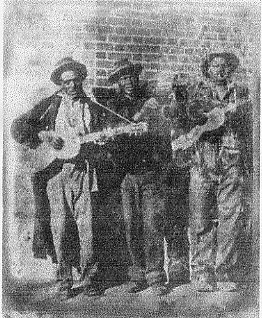
Peg
Leg Howell and his Gang:
Howell on the right, with Henry Williams and Eddie Anthony. On (probably)
Decatur St. c.1928
As to the actual name of this vintage barrelhouse in the late 19th c. I can only really explain the `Slide'. This is of course a description of the main dance step to the dance it refers. Just the same as Trixie Smith's "Give Me That Old Slow Drag" from 1922 or "Louisiana Glide" by that excellent ragtime pianist Blind Leroy Garnett in 1929; and indeed the "Bear hug" mentioned by Peg Leg Howell. But I would have associated familiarity with the beaver, to more Northern climes such as what was formerly Blackfeet country around the North Dakota/Montana border some 1,800 miles northwest of St. Louis, Mo; rather than central Georgia in the Deep South. Around that far north-western land back in 1832, the great chronicler and artist George Catlin noted that the area "abounds in beaver and buffalo,... (but) the American Fur Company... and the numerous parties of trappers are tracing up their streams (the Blackfeet's - Max H.) and rivers, rapidly destroying the beavers which dwell in them." (6). However, a Southern beaver population did exist in earlier times concentrated in the Okefenokee Swamp in south-west Georgia and although "The fur industry of the South never rivaled that of the North,... it was a large part of the economic mainstay of Georgia and South Carolina during the lean years of their early colonisation." (7). Cecile Matschat notes that "As late as 1924 hunters and trappers were still finding the swamp a treasurehold of furs." (8). She claims that by 1938 "Beavers have practically disappeared." (9).
Yet, they were still around in sufficient numbers in 1881 to be featured as part of the name of a barrelhouse in Decatur Street in Atlanta. As well as being picked up by Peg Leg Howell and His Gang as a new dance title in early 1927, the beaver also became the subject, in analogy, of a mini-sermon recorded in 1930 by Rev. M.J. Holt. This is basically an appeal for more funding for "the church programme" to the Sisters in the congregation, even if that means "it call for a little more washin', call for a little more ironin'." Challenging them if the beaver can work harder so could they! In a rasping voice Rev. Holt continues his increasingly intense rapping to the Sisters to raise 68 dollars 50 cents "in the next two weeks".
(Preaching): "An' I know you haven't taken under consideration the hard-workin' beaver. While the beaver has no hands. Just struttin' (?) himself on his journey. But `e gets by with his tail... the beaver throws up a great dam across the water an' stops the streams from runnin' up an' down" (!) (10).
In passing, it might be of interest to note that the recordings by Peg Leg Howell and Rev. M.H. Holt seem to be the only 2 sides in pre-war blues and gospel to include the beaver in their titles.
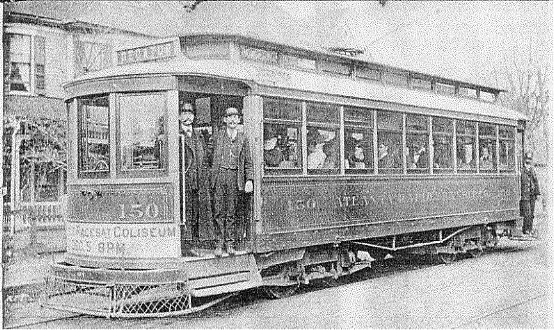
An early street or trolly
car heading for Decatur in 1901. Some places in the South still barred blacks
from riding on these cars: including Peg Leg Howell who was a youthful 20
year-old at this time.
It would seem that the `Beaver Slide' barrelhouse on Decatur Street fostered a steady stream of mean-sounding black string bands over a period of some 45 years, immortalised by Peg Leg Howell And His Gang's recording in 1927.
Max Haymes Aug. 2004
Notes
|
1. Wyatt M. |
Notes to C.D. |
|
2. "Beaver Slide Rag' |
"Peg Leg Howell And His Gang": Peg Leg |
|
|
Howell speech, gtr.; Eddie Anthony speech, |
|
|
An.; Henry Williams gtr., pass. speech. |
|
|
8/4/27. Atlanta, Ga. |
|
3. White S. & G. |
p.159. |
|
4. Ibid. |
|
|
5. Ibid. |
p.164. |
|
6. Catlin G. |
p.51. |
|
7. Matschat C.H. |
p.46. |
|
8. Ibid. |
|
|
9. Ibid. |
|
| 10."The Beaver" |
Rev. M.H. Holt & His Congregation: Rev. M.H. Holt preaching; Bessie Johnson vo.; mixed group vo. responses, moaning; unacc. 26/5/30. Memphis, Tenn. |
References
| l Wyatt Marshall. | Notes to "Violin, Sing The Blues To Me". (African American Fiddlers 1926-1949). Old Hat CD-1002. 1999. |
| 2. White Shane & Graham. | "Stylin'." (African American Expressive Culture from Its Beginnings to the Zoot Suit). Cornell University Press. 1999. (Rep.). l". pub. 1998. |
| 3. Catlin George. | "North American Indians". Edited & Introduction by Peter Matthiessen. Penguin. 1989. |
| 4. Matschat Hulse Cecile. | "Suwannee River" (Strange Green Land). One of the "Rivers of America" series. William Hodge & Co. 1951. (Rep.). 1st. pub. 1938. |
| 5. Discographical details from "Blues & Gospel Records 1890-1943". Robert M.W. Dixon. John Godrich & Howard Rye. 4th. ed. (Rev.). Clarendon Press. Oxford. 1997. | |
| 6. Corrections/additions & transcriptions by Max Haymes. | |
Illustrations
| 1. Oliver Paul. | p.37. "Songsters & Saints".(Vocal Traditions On Race Records). Cambridge University Press. 1984. |
| 2. Garrett Franklin M. | p.93. "Yesterday's Atlanta" E.A. Seeman Publishing Inc. 1975. (Rep.). |
Discography
| 1. Beaver Slide Rag | Old Hat CD-1002. Ibid. |
| 2. The Beaver | Document DOCD-5548. "Preachers And Congregations Vo1.4 1924-1931." 1997. |
Max Haymes, August 2004
Essay © Copyright 2004 Max Haymes. All rights reserved.
Website © Copyright 2000-2006 Alan
White. All Rights Reserved.
Check out the other essays in the "Background of
Recorded Blues" series:
Background
of Recorded Blues: No. 1 - Pea Vine Blues
Background
of Recorded Blues: No. 2 - Mobile and Western Line
Background
of Recorded Blues: No. 4 - P.C. Railroad Blues
Background
of Recorded Blues: No. 5 - Nut Factory Blues
Background
of Recorded Blues: No. 6 - Big Ship Blues




